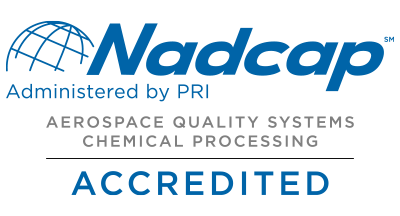Flying High with an Environmentally Friendly Alternative to Chromic Acid Anodize
Chromium, in certain forms, is on its way off of the proverbial production map, and with this comes the swan song of a staple of engineering-centric coatings such as hard chrome chromate conversion coatings and chromic acid anodize (CAA).
Chromic acid anodize, a.k.a. Type I per MIL-DTL-8625, has traditionally been used in the following applications:
- Airframe components due to its increased corrosion resistance
- Tight-tolerance aluminum parts requiring corrosion protection
- Aluminum components adhesively bonded to one another
These attributes have been ideal for aircraft coatings. As its name denotes, chromic acid anodize is an aluminum oxide coating that is created in a chromic acid solution. EH&S and EU legislations (including RoHS, REACH and WEEE) have called for the ban of hexavalent chromium (a.k.a. chromates) not only in coatings but also in the manufacturing process. In response to this trend, in 1990 Boeing developed and patented BoricSulfuric Acid Anodize (BSAA).
Boeing initially licensed the patented process to qualified vendors; however, that patent has since expired. The BSAA oxide coating exhibits many of the same properties as the aluminum oxide coating that is derived from the chromic acid process. The table below shows the similarities and differences between Boric-Sulfuric and Chromic Acid Anodize.
Design Considerations with BSAA
In considering whether or not BSAA would be a functional alternative to the chromic acid anodize you’ve been specifying for years, there is very little to consider. If your parts require hardcoat anodize and chromic anodize on the same part, and your metal finisher has been using chromic acid anodize as a stop-off for the hardcoat, BSAA will not be for you.
Also, because the electrolyte used for developing this coating contains sulfuric acid, there is a chance to entrap solution in welds, crimps, and seams, which can lead to corrosion and part degradation, so parts with these features would not be good candidates for BSAA.
Furthermore, while modifying electrolyte conditions for chromic anodize allows those anodic oxide films to be dyed (black, in particular), BSAA doesn’t permit such a dyed opportunity. While these design considerations have been investigated, there are many more attributes that one might specify CAA for and reasons why it has worked in your application.
It is strongly suggested that you prototype the performance of this coating/part system in your application before bringing it to market. One of the largest benefits of thin anodic films using in the aerospace industry – be it chromic anodize or boric-sulfuric – is their ability to provide corrosion protection without greatly diminishing the fatigue strength of the aluminum base material.
It has been well demonstrated that with increasing oxide film thickness, the fatigue strength of aluminum can degrade by as much as 50% for the thickest, Type III, hardcoat anodize films. Type II sulfuric anodize coatings typically fall in the 25% fatigue reduction realm while the thin Type I films are generally around 5% or less. Prime Specifications Aerospace primes such as Sikorsky have been permitting the switch to BSAA where Type I chromic anodize was specified for years without mandating it.
This may be attributed to the lack of adoption in the metal finishing industry particularly since hexavalent chromium was still required for sealing the anodic film allowing it to meet stringent 336 hour salt spray requirements which is the industry standard for anodizing films. Sikorsky has taken BSAA to the next level of environmental impact by specifying the use of a trivalent chromium seal (e.g. Metalast TCP-HF) over the traditional dilute dichromate. Anoplate is happy to announce that we are approved by Sikorsky to process to Type IC (BSAA) with this seal and have already seen an influx of incoming work to this specification.
While BSAA is suitable as a primer for subsequent adhesive bonding, many primes are looking to other chromic anodize alternatives due to their ability to provide even greater bonding strength although there is no clear direction yet established. For instance, Sikorsky and Bell Helicopter both favor phosphoric acid anodize as optimum for adhesive bonding applications whereas Airbus is turning towards tartaric acid anodize.
It should be clearly stated that while BSAA will exceed the standard corrosion performance threshold exhibited by chromic anodize, neither phosphoric nor tartaric anodize can, thus, these chromic alternatives are relegated to solely applications where only adhesive bonding is required. Boric-Sulfuric Acid Anodize represents a leap forward in providing an environmentally-responsible replacement to chromic acid anodize for straight forward corrosion resistance applications.
Contact Us to discuss switching your parts over to BSAA today.













